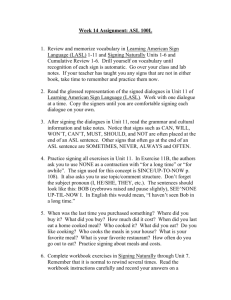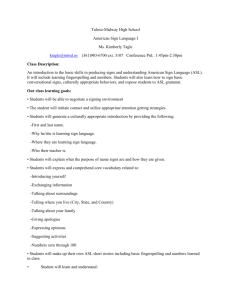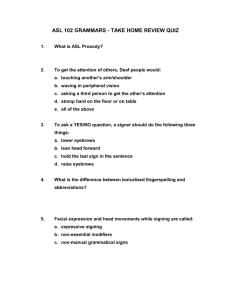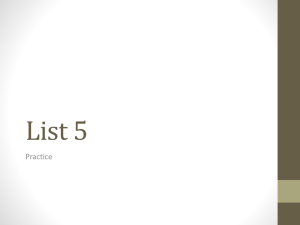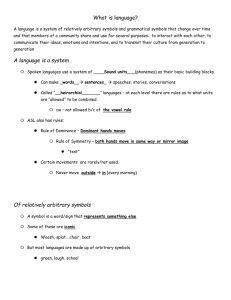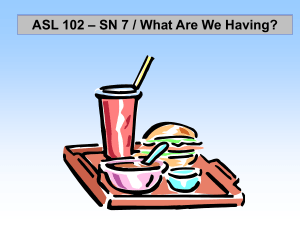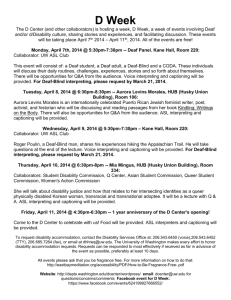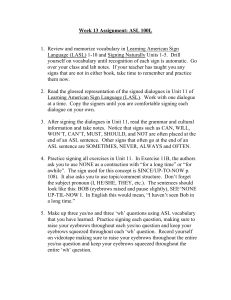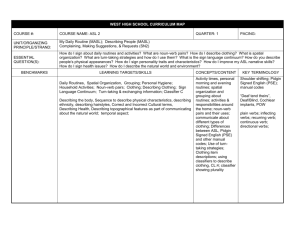Master ASL! Unit 7 Notes: Daily Routine, Grammar, and Culture
advertisement
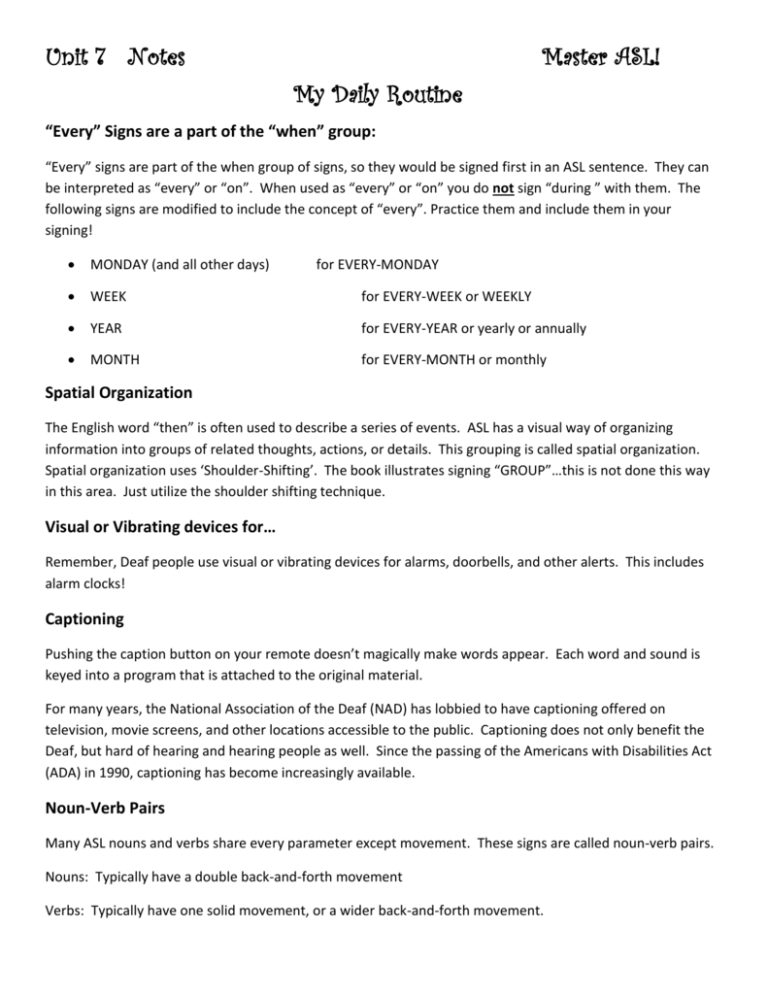
Unit 7 Notes Master ASL! My Daily Routine “Every” Signs are a part of the “when” group: “Every” signs are part of the when group of signs, so they would be signed first in an ASL sentence. They can be interpreted as “every” or “on”. When used as “every” or “on” you do not sign “during ” with them. The following signs are modified to include the concept of “every”. Practice them and include them in your signing! MONDAY (and all other days) WEEK for EVERY-WEEK or WEEKLY YEAR for EVERY-YEAR or yearly or annually MONTH for EVERY-MONTH or monthly for EVERY-MONDAY Spatial Organization The English word “then” is often used to describe a series of events. ASL has a visual way of organizing information into groups of related thoughts, actions, or details. This grouping is called spatial organization. Spatial organization uses ‘Shoulder-Shifting’. The book illustrates signing “GROUP”…this is not done this way in this area. Just utilize the shoulder shifting technique. Visual or Vibrating devices for… Remember, Deaf people use visual or vibrating devices for alarms, doorbells, and other alerts. This includes alarm clocks! Captioning Pushing the caption button on your remote doesn’t magically make words appear. Each word and sound is keyed into a program that is attached to the original material. For many years, the National Association of the Deaf (NAD) has lobbied to have captioning offered on television, movie screens, and other locations accessible to the public. Captioning does not only benefit the Deaf, but hard of hearing and hearing people as well. Since the passing of the Americans with Disabilities Act (ADA) in 1990, captioning has become increasingly available. Noun-Verb Pairs Many ASL nouns and verbs share every parameter except movement. These signs are called noun-verb pairs. Nouns: Typically have a double back-and-forth movement Verbs: Typically have one solid movement, or a wider back-and-forth movement. Another way to understand noun-verb pairs is to think of what the signs show or do. Examples: SCISSORS and to CUT with scissors CHAIR and to SIT ERASE and to ERASE CAR and to DRIVE or DRIVE THERE TELEPHONE and to CALL or to be CALLed “to WEAR” and “CLOTHES”; “to USE” Use the sign “CLOTHES” to sign “WEAR” and the sign “USE” when signing about non-clothing items like glasses and shoes. The Sign Language Continuum: (MASL pages 276 and 277) American Sign Language is a language. English is a language. English codes are systems created to show English on the hands. Pidgin Signed English is a mixture of languages, much like “Spanglish”. (It is usually referred to as a Contact Variety or Language, now.) Look at the four explanations below: 1. ASL is a language: Read the column “American Sign Language”. A visual language is as unique as French or German, ASL exists independent of English and has its own complex grammar and syntax. Like other languages, it cannot be matched or translated sign-for-sign into another signed or spoken language. See the examples for the word “run”. 2. English…is a spoken and heard language. This is called “oral – aural” language. 3. English Codes: Read the column on English Codes. A code is an artificial way of conveying information, like Morse Code or Braille. It is a system that must be memorized. Signing Exact English (SEE) is one code that represents each word in spoken or written English, including prefixes and suffixes. For one word in spoken or written English there is only one SEE sign to represent it, regardless of the concept underlying the word. There are many different English codes. 4. Pidgin Signed English is a mixture of ASL signs/grammar and English type signs/grammar. (It is more often referred to as a Contact Variety or Language now.) Many individuals who know “sign language” actually use ASL signs in English word order. Some signers are “very English” while others are “very ASL”. A PSE signer might not know or use each of the various signs needed for the different meanings of “run”. Describing Clothing Use the topic-comment structure when describing clothing. Topic-comment means the topic (what is being described) comes first, with additional comments following. Turn-taking & Exchanging Information: In spoken languages, turn-taking strategies include raising one’s voice and “talking over” another (though this is considered rude), making various sounds or waiting for a natural pause to interject a comment. Similar strategies apply to signed conversations. Watch for closing signals at the end of statements or questions to be ready to respond naturally, and keep an eye on facial expressions and non-manual signals to know when it is your turn to sign. ASL Turn-Taking Strategies Include: closing signals Question-Maker Face (NMS – eyebrows up) and WH Face (NMS – eyebrows down) using the “HOLD-ON” sign to ask someone to pause or wait moving up your hands to signal to the person signing that you wish to communicate using the “GO-ON” sign to ask someone to continue signing after an interruption or when both signers begin signing at the same time. Signs With More Than One Meaning Try to understand the meaning of a concept, whether it is an ASL sign or an English word. As you learned in Unit 5, the meaning of some signs is influenced by the literal or abstract definition of a word. Some signs have very subtle differences that many hearing signers overlook, like noun-verb pairs, while other nuances that affect meaning are conveyed by non-manual signals. Yet some signs are the same and have different meanings – how does that work? The answer is the two C’s: Concept and Context. Concept refers to the meaning, or intent, the sign is conveying. Context refers to how the word/sign is used in a sentence. The sign for “VOLUNTEER” and “SHIRT” are the same. The meaning will be understood in what the people are discussing. Classifier C CL: C represents cylindrical objects. In this section, the text is having us use the CL: C, and others, as prepositions, instead of in, on, under, over, behind, next to, or in front of. These notes are from Master ASL! Level One.

